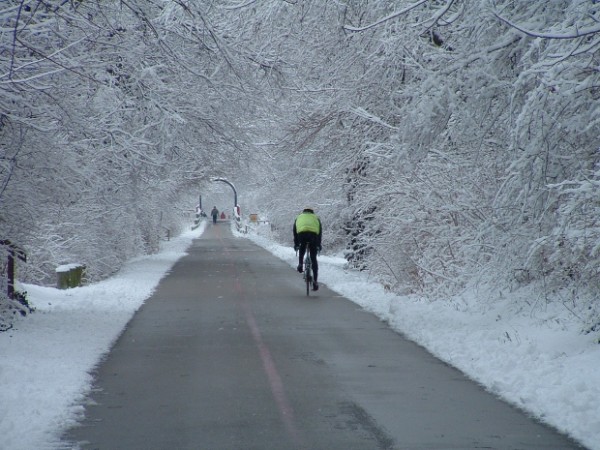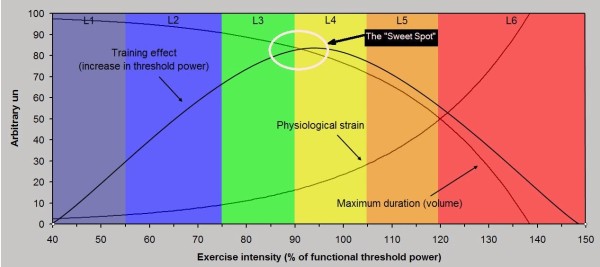By Hunter Allen, PCG Founder/CEO and Master Coach

What you do this winter can really make or break your season in the coming year. Winter training is different for everyone since we live in different areas of the world; some of us spend a solid five months indoors while others can ride outside year around. There are some vital components to creating a very good winter training program no matter where you live, and of course a power meter has a lot to do with it.
Before you embark on your official winter training plan, though, you’ve got to make sure you’re well rested and recovered from the long season. Hopefully you’ve taken a couple of weeks off and given yourself at least two weeks of easy cross-training; this is essential to recharging your physical and mental batteries.
Once you’re rested, recharged, and ready to go, your winter should contain the following four important components: focused indoor training workouts, solid workouts at your sweet spot, a cross-training routine, and balanced rest periods. These four components combine to create a strong winter program that can give you one of your best winters ever. Click through for more on each point so you can use them all to the best advantage…
In most of the United States, the winter is quite cold, which means we will spend at least some of it on the indoor trainer. (All you southern California readers out there, don’t stop reading; just try to incorporate some of these workouts into your outdoor routine.) Even though most of us love riding our bikes outside, the indoor trainer can provide some really great workouts with no real distractions: no cars, no wind, no hills, no dogs. All the things that can get in the way of a focused session aren’t problems on the indoor trainer.
Now that you’re resigned and committed to the indoor trainer, what workouts should you do? There are two basic types of workouts I prescribe to my athletes in the winter: cadence-based workouts and sweet spot workouts. Almost all the workouts my athletes do during this season are some permutation of these two basic types. Cadence-based workouts emphasize cadence changes first, with power and heart rate of second and tertiary importance. Cadence workouts typically do not stress the cardiovascular system but are more focused on improving the muscular system. They can range from high rpm efforts emphasizing neuromuscular power to very slow rpm efforts emphasizing muscular strength.
What is the purpose of cadence-based workouts and why should you do them this winter? The higher cadence workouts help you maintain your ability to quickly contract and relax your muscles, which is a very important skill in cycling. By training your neuromuscular power throughout the winter, you can keep the critical ability to quickly change your cadence and even enhance it.
This type of indoor workout is relatively simple and can also easily be done either indoors or outside. One of my favorites is one-minute fast-pedaling intervals, where you pedal over 110 rpm for one minute and then pedal at your self-selected (normal) cadence for a minute and then repeat. This is a great leg burner, but it doesn’t get the heart rate too high and therefore push your training into more of an anaerobic zone.
On the other side of the coin, lower cadence workouts are also great to do in the winter because they can enhance your muscular strength, which can in turn help you to sprint with more peak wattages and push a bigger gear into the wind in a time trial or up a steep climb. Muscular strength workouts are based around hard but short intervals done in the biggest gear you can manage at low rpm. Many people believe the myth that riding for hours in a big gear at slow rpm will increase muscular strength and make them more powerful, but this only makes you good at riding in a big gear at slow rpm! Riding at 50 rpm for hours on end just doesn’t create enough muscular stress to strengthen the muscles. Consider this analogy: If you’re trying to bench press 200 pounds in the weight room, you need to start at 150 pounds and build up to it with low reps, high sets, and the most weight you can lift. You have to use heavier and heavier weights to stress the muscle in order for it to adapt. If you lifted 100 pounds one million times, you would never adapt to lifting 200 pounds one time. The “big gear” myth is similar; when you pedal at 50 rpm for hours on end, it’s just like lifting 100 pounds for a million reps. While 100 pounds (metaphorically speaking) is more than your normal pedaling force of 80 pounds, it’s just not enough stress on the muscles to get them to strengthen. In order to increase your muscular strength on the bike, you need to do hard, short bursts of effort in a big gear. For example, put your chain in the 53:12 gear and slow down to about 8-10 mph, then (staying seated) tighten your abdominals, grip your handlebars tightly, and with all your might turn that gear over until you reach 80 rpm. Once you reach 80 rpm, the amount of force you’re putting on the cranks has reduced to a point at which it’s just not enough stress to create muscular strength improvements. You should plan on doing about twenty of these power bursts in a session to create enough of an overload to achieve some benefit.
The second type of training I prescribe to my athletes in the winter is called sweet spot training (SST). When you ride just below your functional threshold power (FTP) at approximately 88-93% of your FTP, you are riding in your sweet spot. Why is it called the sweet spot? As shown on the chart below, when you’re in this area of intensity, the level of physiological strain (read: amount of pain) is relatively low, while the maximum duration (read: length of time) that you can stay in this area is quite high. You can also see that your increase in FTP is greatest in this area, so training in your sweet spot really gives you a tremendous bang for your buck.
When you do SST, start out with 15- to 30-minute efforts and gradually build up to 60- to 120-minute efforts if you can. These efforts aren’t easy ones, but you’ll get a tremendous cardiovascular benefit from them. Make sure to do at least one to two sessions each week, and you’ll see a big difference in your FTP come February.
Cross-training is another key to winter success. One of the most important cross-training exercises you can do this winter is some type of core abdominal exercises combined with stretching. A Pilates or yoga class can really help you develop strong abdominals, which in turn help you transfer energy from your upper body to your legs and protect your back from injury. If you can, take a class or do a video every week; that will be enough to make a difference. For cardiovascular work, I recommend doing some mountain biking, hiking, trail running, roller blading, and cross-country skiing (if you have the snow). Just keep it fun and not too intense, as cross-training is supposed to enhance your cycling, not cause injury or major cardiovascular stress. Cross-training is great to do in the off-season, since we don’t really move our muscles in multiple planes on the bicycle, and will provide some great muscular and cardiovascular stimulus.
A word of caution about starting any new exercise: take it easy for the first two weeks. I once had a client who was very fit and decided to go out and run ten miles in the first day of cross-training. Needless to say, he was barely able to walk for the next two weeks. He also inadvertently pulled a muscle, which forced him to take three weeks off from all training. So be careful and break yourself in slowly when you start a new exercise.
The final component of a successful winter program is rest. It doesn’t sound like it’s that big of a deal, but too much training in the winter will make you a “January star.” It’s great to train hard in the winter, and it’s the key to really pushing yourself to the next level for the coming year, but if you constantly train hard in the winter, you’ll peak in January. The key to increasing your FTP this winter and making it your new normal fitness level is to train intensely for only two days in a row. After two intense days, give yourself a rest before coming back to training, except every other week give yourself two days of easy training after two hard days instead of resting so you can keep your battery charged. Your goal this winter is to never let your battery charge go below 97%. Two days of hard training will bring your battery down to 97%, and a day off or a day of easy training will allow it to recharge back to 100%. This way you can balance hard training with proper rest and enter the season fresh and strong, without turning into one of those riders that wins all the January rides!
These four components of winter training all combine successfully to ensure you create your best winter of training ever. A proper winter program will push your FTP up to the next level, maintain your ability to change cadences, and put you at the start of the season with a fresh mind and ready body for a strong and long season! Be sure to keep your focus this winter. This season really is the time for you to rise to the next level and make next year a breakthrough season!
 Hunter Allen is a USA Cycling Level 1 coach and former professional cyclist. He is the coauthor of Training and Racing with a Power Meter and Cutting-Edge Cycling, co-developer of TrainingPeaks’ WKO software, and CEO and founder of Peaks Coaching Group. He and his coaches create custom training plans for all levels of athletes, and Hunter can be contacted directly through PeaksCoachingGroup.com. Get more great training tips and advice on the Hunter Allen Power Blog.
Hunter Allen is a USA Cycling Level 1 coach and former professional cyclist. He is the coauthor of Training and Racing with a Power Meter and Cutting-Edge Cycling, co-developer of TrainingPeaks’ WKO software, and CEO and founder of Peaks Coaching Group. He and his coaches create custom training plans for all levels of athletes, and Hunter can be contacted directly through PeaksCoachingGroup.com. Get more great training tips and advice on the Hunter Allen Power Blog.
